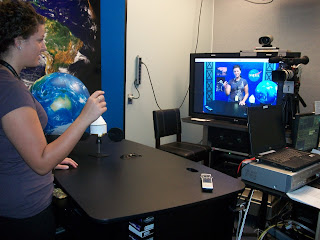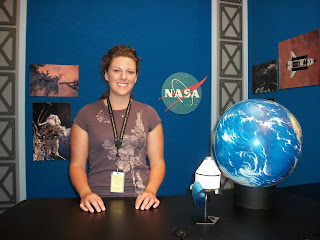About halfway through my first official year of college, I came across a promotional 'ad' at my school for a new program called National Community College Aerospace Scholars (NCAS). This would be the first year that NASA would sponsor the NCAS program, and I recognized much of what I saw. The program had a similar layout to the Washington Aerospace Scholar program. The only difference was that students traveled to NASA Johnson Space Center for a 3-day on-site event if they excelled in the online portion of the program. Of course, I had to apply!
The online portion focused on the development of a Mars Rover. Students had four projects to complete in 8 weeks. The first project was to write a proposal for a mission to Mars. The second project was to develop a tentative time line and choose a landing site for the mission. The third and fourth projects tied everything together. One being the final mission proposal including time line and description of experiments and operations of the rover, and the second being the schematics and line drawings of the rover that we designed ourselves. Here is the final product:
First, my final Mission Proposal
In order to send a manned mission to Mars, it is important to first explore and test for potential risks. By sending robotics missions, the risk to humans is eliminated while useful data about Mars' environment can be collected. This mission will do just that. Two of the main objectives of this mission are to use drilling technology integrated into the rover to find the hardness of the Martian surface, and to test underground for radiation levels. The third objective is to experiment with small scale wind power technology to see if the powerful Martian wind storms can be harnessed into useful energy. Crucial to a manned mission to Mars, is finding out if humans can survive the radiation levels on the surface. If it is found that radiation levels are significantly less harmful to humans just feet below the surface, housing pods can be built underground in potential future manned missions to Mars. Energy sources on Mars are limited, so if it can be determined that wind power can be generated along with solar power, the options for robotic energy systems increase.
To begin this mission, the robotic mission to Mars will launch from Earth on July 27, 2018. During this time, Earth and Mars are at opposition, and the distance between them is shorter than usual. Thus, the time it takes the spacecraft to reach Mars is significantly less. The due arrival date to Mars is late February to early March of 2019. The rover will stay on Mars for a duration of approximately 20 months. There will be many benefits to waiting until 2020 to return to Earth. First, this will allow adequate time to perform all tests and experiments. Second, in order to bring the rover back from Mars, the spacecraft must be intact and equipped with the right amount of fuel to launch from the Martian surface. Thus, it is best to wait until the next opposition. The mission will be cheaper and more efficient if less fuel is needed to be stowed away for the return trip home. The spacecraft will launch from the surface of Mars on October 13, 2020 and should arrive back to Earth May or June of 2021, approximately 3 years after its departure from Earth.
The spacecraft will use a Mini-Magnetospheric Plasma Propulsion (M2P2) Device. This system utilizes energy from solar wind to provide enhanced propulsion. It creates a magnetic field, then plasma is injected, resulting in an inflated 'magnetic bubble' tens of kilometers in diameter. The bubble intercepts and deflects the solar wind, which has a velocity between 350 and 800 km/s. The momentum acquired from the solar wind is sufficient to raise or lower the orbit of the spacecraft (Winglee). This will largely reduce the amount of fuel needed for the mission, and greatly lower the mass of the spacecraft. During approach, the lander will also use aerobrakes in the Martian atmosphere and aerocapture. It will then use parachutes and large airbags to land on the surface.
The spacecraft will land in Hellas Planitia, the largest impact crater on Mars. Hellas Planitia was chosen as the landing sight because it is fairly even terrain. This depressed basin lies approximately 4 km below the datum surface and is the lowest known feature on the surface of Mars (Darling). If future human missions are sent to Mars, they would likely be sent to a crater similar to this one for many purposes. First and foremost, is because a flat open terrain is easy for the rover to move and conduct experiments.
The rover will be built with numerous systems, many of which are similar to the current technology being used for the Spirit and Opportunity missions. The rover will be powered by solar panels and a back up non-rechargeable battery. There will also be an experimental wind power system, but this will not be a major source of power. Communications will be set up independently of the lander, and the rover will communicate directly with Earth. A camera will send high resolution pictures of the rovers surroundings, and send data and messages to Earth using high and low gain antennas. The cameras are stereoscopic charged-couple device (CCD) cameras. These are much like that of digital cameras, not TV cameras. The rover will also include an experimental package that carries the drill and wind power generators.
The drill is to be used to dig below the surface as far as it can and conduct an experiment to determine if radiation levels below the surface are still dangerous to humans. At the same time, it will record data about the composition of materials below the surface and the depth at which it is able to drill. The drill is designed to operate independently of the rover, thus it needs to be able to transmit data back to the rover. To do this, the drill is attached to nine meters of thin cables that send data to the rover, where it is then sent to Earth. The drill includes remote sensing chip that allows it to work around hard areas. It compares its position to that of the rover at the surface, and this increases accuracy by only drilling downwards and only a certain distance from the rover. The drill also carries a gamma ray spectrometer that senses cosmic and solar radiation levels below the surface.
The last experiment to be performed by the rover involves using a windmill to generate wind power from not only Martian winds, but powerful dust storms. This device raises out of the top of the rover during higher winds and is designed much like that of a windmill with cupped blades. This allows for the particles of dust to benefit the motion of the generator by causing an extra force. A computer chip inside the rover records and stores data about the amounts of power generated. Even though it is possible that the wind power generated is too small to utilize, the system is an extra feature to the rover, and if no power is generated, the rover still functions from solar and other power sources.
Works Cited:
Darling, David. Hellas Planitia. The Internet Encyclopedia of Science. <http://www.daviddarling.info/ encyclopedia/H/Hellas_Planitia.html>
Mars Missions: Spirit and Opportunity. National Aeronautics and Space Administration. 21 Jan 2010. <https://aerospacescholars.jsc.nasa.gov/ncas/modules/2010/11.cfm>
Winglee, Robert. Incorporation of the Mini-Magnetospheric Plasma Propulsion System (M2P2) in a Manned Mission to Mars. University of Washington Department of Aeronautics and Astronautics. <http://www.lpi.usra.edu/publications/reports/CB-1106/wash01.pdf>
My Final Rover Schematic
Once again, my hard work paid off and I was selected to go to NASA! In late May, we arrived at Johnson Space Center and didn't waste a moment. We arrived on site at Johnson Space Center (JSC) at around 4pm and jumped right into work! We had the remainder of the evening to layout and submit a company name, logo, motto, and infrastructure for our team. I was selected by my peers as our team's Project Engineer and took an immediate leadership role, assessing everyone's strengths and weaknesses and assigning tasks and positions.
While our team engineers began working on a rover prototype design, our advertising and development managers began designing our logo and the schematics for our rover. The next morning we demonstrated and presented our initial rover design to a panel of NASA judges, and they gave us feedback on what to fix in our final design.
Testing our Rover's capabilities
We heard from Apollo Flight Director, Gene Kranz, and other guest speakers. We also toured Johnson Space Center, visiting the Neutral Buoyancy Laboratory, the full scale Mock-Up facility, and Mission Control Center. On the last day, we formally presented our company and pitched our rover design and mission plan to NASA and the other students. The judges selected a team that they would want to represent NASA and the design and mission plan that best accomplished the goal.
Touring the Neutral Buoyancy Laboratory
Mission Control Center
Apollo Flight Director, Gene Kranz, giving his "Failure is Not an Option" Speech
Historic Mission Control - Sitting in the best seat in the house!
Company name: Gray Sleuth & Our finished Rover
Go Grey Team!
The Grey Team in front of the Saturn V Rocket
The experience was one that I will never forget! As soon as I saw what was really happening here at NASA I was amazed. The technological developments and research going on at NASA really influenced me to do better in school and continue to excel so that I could work there someday.



















